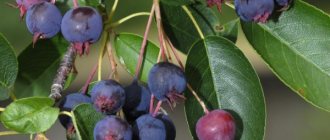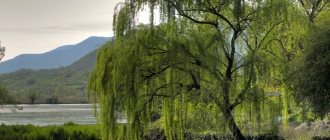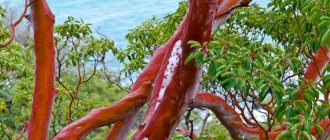Magnolia is a magnificent evergreen shrub that grows in the Crimea and the Caucasus. It blooms with beautiful white flowers and has an unforgettable aroma. Magnolia is the oldest plant that lived on earth approximately 140 million years ago. The first trees found the era of dinosaurs on Earth. But now it is considered exotic, since magnolia has a beautiful crown and spectacular fragrant flowers.
Magnolia - description and types
Although magnolia is considered a shrub, in the wild it reaches a tree up to 30 m high. The leaves of the bush are dark green in color and have an elliptical shape. The flowers are often white when opened and reach a diameter of 15 cm and have a fragrant aroma.
Magnolia blooms on the sea coast throughout the warm season. After flowering, a fruit with large seeds is formed, resembling a pine cone in appearance. The bark of the tree is gray in color, smooth and sometimes scaly to the touch.
There are species that live a little further north than is commonly believed. Therefore, garden centers began selling this plant. Unfortunately, it does not take root well in central Russia, since the climatic conditions of this region are not at all suitable for it.
Those gardeners who take the risk of planting star magnolia or lily-flowered magnolia insulate it for the winter. Since frosts can damage the delicate buds of this southern plant.
Magnolia in the city
There are universally popular plant introduction centers with many different varieties:
- Royal Botanic Gardens, Kew (England) - has 40 species.
- Arnold Arboretum (USA) - has 46 species.
- The Kiev Botanical Garden has 15 species, 4 hybrids and 22 plant forms.
- in St. Petersburg, Siebold magnolia grows and bears fruit in open ground.
- magnolia Kobus has taken root in Moscow and Smolensk.
- Kobum and Sulanzha magnolias grow in Vladivostok.
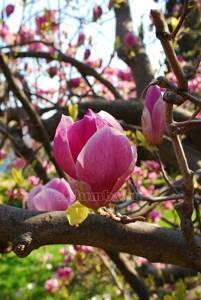
Magnolia Sulanja
Here are the individual types of magnolias:
Magnolia pointed
A large tree with pointed leaves 20 cm long. The flowers are yellow-green in color and bloom when the tree already has foliage. It has a pyramidal crown shape, which gradually develops into a spherical shape. Loves moisture and grows in nature up to 24 m in height.
Star-shaped
It is either a shrub or a tree with a dense spherical crown. It grows no more than 6 m tall, with a bush diameter of about 3.5 m. The dark green foliage turns yellow in October. Very fragrant flowers with a diameter of 10 cm begin to bloom in April, but since this bloom is not friendly, the flowering stretches for almost a month.
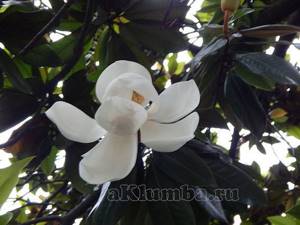
Magnolia Siebold
This is a very beautiful shrub, 4 m tall, with long leaves and white fragrant flowers located on a drooping peduncle. It begins to bloom after the foliage emerges.
Willow
This species rarely appears on sale. The tree grows up to 10 m tall with a pyramidal crown shape. The tree has smooth silvery bark. Flowers with a diameter of 8 cm have a wonderful aroma. This plant is easily grown from seeds and blooms within the 5th year.
Types of magnolia video
Types of magnolia
Magnolias are divided into evergreen and deciduous. The former are not adapted to our winters and require special conditions. The sensitivity of deciduous species to cold influences only the timing of flowering. The following types of magnolias are cold-resistant:
:
- star-shaped;
- kobus;
- pointed;
- three-lobed;
- willow;
- Siebold;
- Lebner.
Garden forms of Ash and Soulange have relative winter hardiness.
Magnolia acuminate
A deciduous tree with a broad pyramidal rounded crown that can reach 30 m in height. The leaves are elliptical in shape, from 10 to 25 cm long, 9-15 cm wide. Under natural conditions it grows in the central and eastern parts of North America.
The pointed magnolia blooms along with the appearance of leaves - in the second half of May or in June. The flowers are small, up to 7 cm in length, bell-shaped, without aroma. The fruiting period is the end of September – October. The fruits are collective leaflets, which when unripe are light green in color and look like a cucumber up to 10 cm long, and when ripe they are bright crimson-red in color with 3-7 seeds.
Magnolia stellata
A deciduous tree that can reach 4 meters in height. The natural range covers the Japanese island of Honshu. It grows mainly in damp mountain forests, often in a bushy form. The leaves are relatively narrow, elliptical or ovoid in shape. Their length is about 11 cm, width – 4 cm.
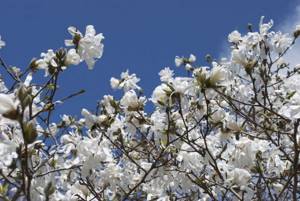
The flowering period begins in March-April, even before the leaves appear. The flowers are white, with a pleasant aroma. Their diameter is about 9 cm. The fruits are assembled leaflets of a cylindrical, pointed shape, about 5-6 cm long. Their color is greenish, and on the illuminated side it is pink-red.
Magnolia sieboldii
One of the most frost-resistant species. Under natural conditions it grows in Japan, China, Manchuria, and also on the Korean Peninsula. Grows along mountain rivers.
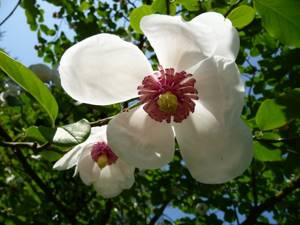
It is a large, wide bush or deciduous tree 6-8 meters high. The leaves are elliptical in shape, up to 15 cm long and up to 9 cm wide. The flowering period lasts from May to June, after the leaves bloom. The flowers are quite large - up to 10 cm, white in color with a pleasant aroma. First they are cup-shaped, then saucer-shaped. Magnolia Siebold bears fruit in late September - October. The fruits are many raspberry-colored leaves of an oblong shape.
Magnolia kobus
A deciduous tree that can grow up to 30 meters and has a bushy appearance. The natural range covers Japan and Korea. Grows on hillsides and along rivers. This is one of the most cold-resistant species. Young trees have a narrow pyramidal crown, which, when fruiting, takes on a rounded tent-shaped shape. The leaves are about 11 cm long and 5 cm wide.
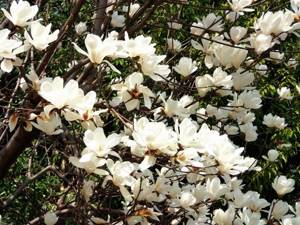
The flowering period begins in April-May, before new leaves appear. The flowers are milky in color and have a pleasant aroma. Their diameter is about 11 cm. Magnolia kobus begins to bear fruit in September-October. The fruits are a cylindrical leaflet, 8 to 12 cm long, which is green at first and then acquires a red-brown hue, and bright crimson on the sunny side.
Magnolia grandiflora
Found naturally in the southeastern regions of the United States. It is grown as an ornamental plant in Central Asia, in Georgia, the Krasnodar Territory, the Astrakhan Region, and also in the Crimea. Usually grows in swampy forests on river banks.
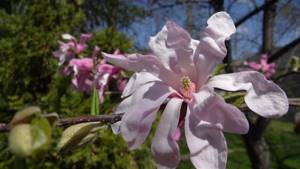
Magnolia grandiflora is an evergreen tree reaching 30 meters in height. The crown is wide-pyramidal and dense. The leaves are large, from 12 to 25 cm long, from 4 to 12 cm wide.
Flowering continues from late spring to early autumn, with individual flowers appearing in October and even November. The flowers are milky in color, quite large - they can reach 25 cm in diameter. The aroma is quite strong. Magnolia grandiflora bears fruit from October to November. The fruits are cone-shaped multi-leaflets up to 1 cm long.
Magnolia loebneri
A low tree or bush about 3-5 meters high. It is a hybrid of star magnolia and kobus, resistant to winter. The flowering period begins in May, even before the leaves bloom. The flowers are multi-petaled and can reach 15 cm in diameter. Their color is soft pink and the inside is white. Flowering is abundant. The fruits are multi-leafed, scarlet in color.
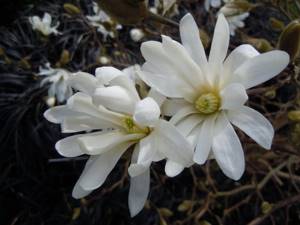
Magnolia liliiflora
The natural range covers the Chinese provinces of Sichuan and Hubei. Cultivated on the Black Sea coast. It is a shrub with an average height of 3 meters and strongly intertwined branches. The crown is slightly stretched to the sides and has a spherical shape. The leaves reach 20 cm in length and 10 cm in width.
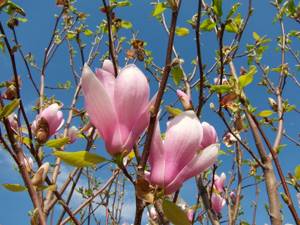
Flowering occurs in March-April and almost coincides with the blooming of leaves; sometimes single flowers appear in summer and autumn. The flowers are narrowly goblet-shaped, about 3-4 cm in diameter. On the outside they have a red-crimson hue, and the inside is white. There is practically no aroma. Magnolia Liliaceae begins to bear fruit in October-November. The fruits are in the form of a collective leaflet of a reddish hue, up to 9 cm long.
Magnolia soulangeana
It is a deciduous shrub up to 5 meters in height, and in the southern regions - in the form of a tree it can reach 12 meters. It is a hybrid of magnolia nuda and liliaceae. It has fairly large leaves of a light green hue.

Magnolia Sulanja begins to bloom together with the leaves blooming, in mid-spring. The flowers are large, goblet-shaped. Their size can reach 15 cm, and for garden forms - 25 cm. The outside shade of the petals varies from light pink to crimson, the inside is white. The aroma is very subtle or practically absent. Fruiting period is October. The fruits are pinkish-purple aggregate leaflets from 8 to 16 cm in length, from 3 to 7 cm in width.
Successful cultivation of an exotic beauty depends on the selected species, its cold resistance characteristics and growing conditions. Despite the fact that magnolias are an unusual plant for the middle zone, you can grow them in your summer cottage without much difficulty and admire the delightful blooms during the summer months.
Planting and caring for magnolia
When planting a plant, you need to choose the right place. The microclimate of a place, even in one garden, will greatly decide. Magnolia should be planted on the south side, protected from cold winds. There is no need to plant this tree in the shade, since in central Russia there will not be enough sun for it anyway.
The plant needs abundant watering throughout its growth period in the warm season. The tree does not need special pruning; only branches that have dried out are cut down. It is advisable to cover the plant until it is 3-4 years old, but later this will no longer be necessary due to the enormous growth of the tree. And he’s not in danger of freezing at this age.
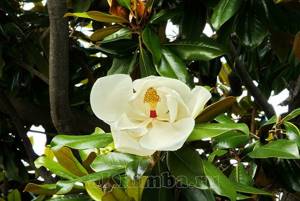
Necessary conditions for successfully growing magnolias in the middle zone:
- If the plant is planted correctly, it will grow actively and bloom profusely all summer. If there is little rain in the summer, then you will need to take care of watering the plant, since it does not tolerate drought;
- In a radius of up to one meter around the tree, the soil is mulched to reduce the loss of moisture from the soil. It is not recommended to dig the ground around magnolia, as it has shallow roots.
- During crown growth and flowering, it is necessary to fertilize the plant with full mineral fertilizer so that it has enough strength to create a luxurious crown;
- After the leaves have completely fallen in November, the soil around the tree is insulated with a layer of about 30 cm of fallen leaves. This leaf cushion will serve as insulation for the roots.
- Since there is no need to form a crown, only drying or frostbitten branches need to be trimmed. The sections are treated with garden varnish.
- If the leaves turn yellow from chlorosis, then the ground around the plant is watered with an iron chelate solution.
Magnolia blossom
In reality, many magnolias begin to bloom only after 8-10 years. And this is under favorable conditions. The colors of their fragrant flowers are very diverse. There are magnolias that first produce flowers and then leaves, and there are also vice versa, which bloom when the foliage has grown. Both options look amazing.
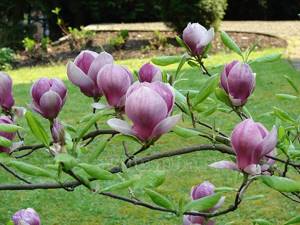
Magnolia blossom
Unfortunately, everything ends, and when the flowering comes to an end, the magnolia petals slowly fall to the ground. Gardeners who have seen this phenomenon call it “magnolia rain.”
It is not recommended to sleep under a blooming magnolia, as the aroma of the flowers is poisonous and inhaling it for a long time can cause a severe headache.
Caring for magnolia in the garden
Growing a tree in conditions that are comfortable for it allows you to achieve annual and abundant flowering. When caring for magnolia, you need to remember about regular watering during periods of no rain.
The young plant does not tolerate drought well due to the shallow root system, which suffers from a lack of moisture in the summer heat, and in the first 2 years after planting, the seedlings are especially sensitive to water deficiency.
The trees are irrigated abundantly 2 times a week, subject to dry weather. It is advisable that the water is not cold. Adult specimens are able to tolerate short-term drought.
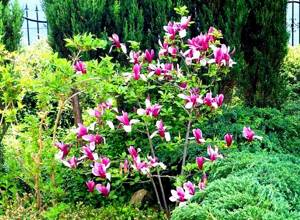
To avoid rapid drying of the soil and reduce overheating and evaporation of moisture, it is recommended to mulch the soil in the near-trunk area with a layer of peat, pine bark or pine needles, since these components will also help maintain the necessary acidity.
When caring for magnolia, avoid deep loosening, as the tool can damage young roots located close to the surface.
Seedlings planted in fertile soil do not need fertilizing in the first few years. In the future, it is enough to lay a layer of mulch from mature compost or humus around the tree in the spring.
Soil mulching function and types of garden mulches
You can also sprinkle a 1-2 cm layer of soil for rhododendrons and azaleas within the radius of the crown. This substrate contains fertilizers that automatically provide fertilizing and maintain soil acidity.
Magnolias do not require formative pruning to care for. Only dry branches damaged by frost or wind, as well as shoots growing inside the crown, are removed. Old specimens of bush species can be rejuvenated once every 6-7 years by cutting off all shoots to a level of 60 cm from the ground surface.
The pruning procedure is carried out only from June, since the plant is characterized by intense spring sap flow and, if wounded, can simply bleed out juice and dry out.
Magnolia propagation
Magnolia can be propagated in various ways:
- cuttings;
- seed propagation;
- through vaccination.
Seed propagation
Magnolia seeds are formed after flowering and are enclosed in a red seed capsule, which protects the seeds from unfavorable environmental conditions. The best germination is achieved by fresh seeds planted in the fall. Plant the seeds in boxes with loose nutritious soil. After sowing, the boxes are transferred to the basement with a temperature of about +5 degrees for the whole winter.
We can also say that seeds collected from magnolias growing in Ukraine or Vladivostok acclimatize better in central Russia and subsequently winter better. Seeds collected from southern beauties grown in the Caucasus adapt very poorly to the northern regions.
The first year for sprouted magnolia seeds is very difficult; only in June do the first true leaves grow and continue to grow actively in September. Since seedlings have a protracted growth cycle, they are transferred to a winter garden or lowered into a frost-free basement for the winter. In the second year of their life, seedlings that have grown to 25 cm are picked.

They are planted either directly in the field, planted in rows so that in case of cold weather they can be covered with lutrasil. Or they dive into containers for better plant care. The soil for seedlings must be breathable and nutritious.
Seedlings planted in pots are heavily watered all summer, protecting them from cold winds. Seedlings need to be fed twice a month with full mineral fertilizer. In the second year of their life, seedlings grow very intensively and from a small seedling 15 cm tall, seedlings grow about half a meter. But such trees still do not overwinter in open ground; the tubs are brought into greenhouses and there they continue to grow foliage until January.
In the spring, three-year-old seedlings are ready for planting in a permanent place, but during their first winter they still require shelter so as not to frostbite the growth buds at the ends of the young branches.
Plants planted for cultivation in ridges of the main soil are well insulated for the winter period with the help of a greenhouse built around a row of young magnolias.
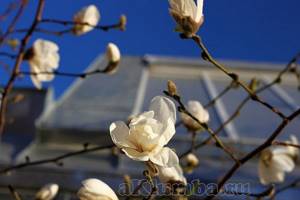
This painstaking method solves two problems. The plant grows excellent leaf mass in one season and is able to withstand the unfavorable conditions of the central regions in the third year. And then if the ends of the branches freeze, the tree loses its beautiful shape and then becomes a bush.
Cuttings and grafting
These methods are almost never used, since this requires having a queen cell on hand, and this is not always possible.
Magnolia care
Growing and caring for magnolia is the usual sequence of operations necessary for the development and growth of any tree, nothing more.
Watering
It is especially important (especially when it comes to one-, two-, and three-year-old plants). Watering should not be a formal procedure - the soil should be constantly moderately moist (but at the same time breathable, not flooded). Mulching helps both maintain the required moisture content and (in winter) protect the roots from freezing.
Shelter
With any “iron” guarantee of winter hardiness, young seedlings at the end of autumn need insulation (burlap, lutrasil). This should be done after the first slight “rigor” of the soil, wrapping not only the branches and trunk, but also its base in such a way that the shelter does not become a refuge for mice.
The shelter should also be maintained in the spring to prevent damage to plants by frosts that are still likely to occur.
Trimming
Magnolias do not need formative pruning, but sanitary pruning should be the rule - dry, frostbitten, mouse-gnawed branches should have no place on the tree. To facilitate wound healing, use high-quality garden varnish.
Fertilizer and feeding
Until 2-3 years of age, the crop does not require them; at older ages, mineral fertilizers are used in the form of ready-made, balanced complexes. They begin to fertilize after the roots have fully awakened in spring and finish a little earlier than the period of complete dormancy (no later than mid-August). The frequency of application is once a month (one watering is combined with fertilizing), the dosage corresponds to that indicated on the container.
If you wish, you can make your own fertilizer mixture (per 10 liters) from:
- 20 g ammonium nitrate;
- 15 g of carbamide (urea);
- 1 kg mullein.
Each tree needs approximately 40 liters of water when feeding.
If there is an excess of fertilizers in the soil, the leaves of the crop may dry out prematurely. This means that watering should be temporarily increased.
Magnolia diseases
Magnolias practically do not get sick, but sometimes gardeners make mistakes when growing this plant.
- With an overdose of fertilizer, magnolia growth stops and the salinity of the soil around the plant increases. The leaves begin to dry out in the summer. All this can be corrected by watering the tree very generously with warm water every seven days.
- In hot weather, the tree may be attacked by spider mites. You need to fight it with actellik, spilling it on the ground and spraying the tree. If you do not treat it, the tree will dry out.
- If there is a lot of lime in the soil, the magnolia roots begin to ache and a disease called chlorosis appears on the leaves. In such soil, magnolia can live no more than one year. Therefore, if the site has calcareous soil, then the only way out is to dig a hole for planting and replace the unnecessary soil with fertile one.
- Insufficient watering leads to the death of the plant, so additional watering is required during the heat of summer.
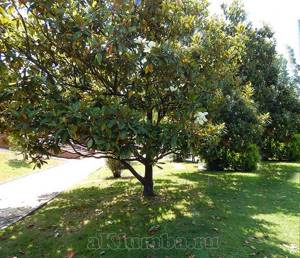
Applications of magnolia
First of all, you need to know that magnolia, like tansy, is a poisonous plant. But it also contains many useful substances:
- essential oils;
- routine;
- flavone glycosides;
- rich in alkaloids.
Magnolia extract is used to make a tincture that helps with high blood pressure; bronchial asthma is also treated with tincture. Magnolia is used as an antiseptic and, with its assistance, destroys bacteria that cause caries.
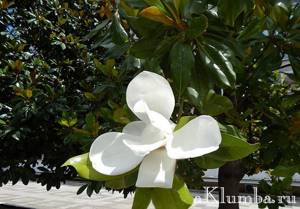
Seed pods are rich in fatty oils containing unsaturated acids:
- oleic;
- peanut;
- myristic;
- stearic
This tree is famous not only for its beauty. There are many traditional medicine recipes to help with various diseases. After all, all parts of the plant are suitable for treating humans. An extract is prepared from the plant, which is used for various human diseases.
For hypertension
For this disease, an alcohol extract from this plant is used. To prepare the extract, you need to grind magnolia seeds and add 200 grams to the resulting 2 teaspoons. 70% alcohol. This remedy is infused for 14 days, and then a course of treatment is carried out. The tincture is taken three times a day after meals, 25 drops.
To strengthen hair
A decoction for strengthening hair is made from the leaves. It is prepared from 3 tablespoons of crushed plant leaves, steamed with a liter of boiling water. Leave for a day and use when rinsing hair after washing with regular shampoo.

April is the time for magnolias to bloom
12.04.2019 Magnolia
(lat.
Magnolia
) is a large genus of flowering evergreen or deciduous plants, trees and shrubs originating from East Asia and America.
It received its name in 1703, in honor of the French botanist Pierre Magnol
, whose friend was the famous naturalist
Charles Plumier
, who saw this beautiful flowering tree on the island of Martinique and first described it.
In 1735, Carl Linnaeus
officially included the genus name Magnolia in the first edition of his work Systema Naturae.
Magnolia can rightfully be called a relict plant, since botanical research confirms its existence more than 95 million years ago. The fossilized remains of trees discovered during archaeological excavations date back to the Cretaceous period. One of the confirmations of ancient origin is the adaptability of magnolia flowers to pollination by beetles. Magnolia already existed at that stage of evolution when there were no bees yet. The structure of the perianth is also interesting: the buds appear as if from a solid capsule that does not have a clear division into individual sepals.
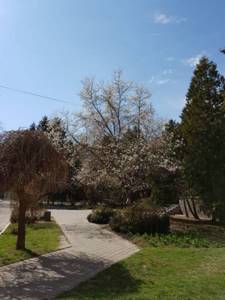
There are about 300 species of magnolia, mostly represented by ornamental plants. The elegant, festive appearance of flowering trees with large, showy, fragrant flowers attracts the attention of not only gardening and landscape design professionals, but also ordinary nature lovers. Magnolia is a slightly toxic plant: its wood and bark contain the alkaloid magnoflorine.
, which can adversely affect the mucous membrane and skin of humans.
Some species, such as Magnolia officinalis
(lat.
Magnolia officinalis
) have long been used (bark, leaves) in official and traditional Chinese medicine.
Flowers of many types are used in cooking. For example, in England, evergreen magnolia
(lat.
Magnolia grandiflora
) are pickled and used as a spicy seasoning. In the cuisines of some Asian countries, pickled buds serve as an aromatic ingredient in rice dishes, as well as in the preparation of an aromatic tea drink.

In Japan, young leaves and buds of magnolia obovate
(lat.
Magnolia hypoleuca
) fried and eaten as a vegetable.
The dried leaves are placed in soup along with leeks, daikon radishes, shiitake mushrooms, and the powder from them serves as a seasoning for meat, fish, vegetable, mushroom dishes, as well as traditional miso hoba
. Interestingly, in some areas of Japan, magnolia leaves are used as packaging for dishes and food products.
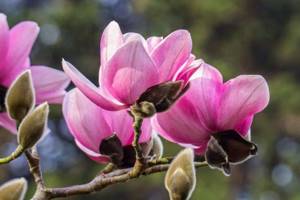
But it is the decorative qualities of the plant that are of greatest interest. Some types of magnolias, such as the star magnolia
(lat.
Magnolia stellata
) or tree
magnolia Sulange
(lat.
Magnolia soulangeana
) delight with their flowering in early spring, before the leaves appear.
In the temperate climate zone, a very popular species, due to its high cold resistance, is magnolia kobus
(lat.
Magnolia kobus
). Its natural habitat is the territory of Japan (Koshu, Honshu, Hokkaido islands) and Korea.
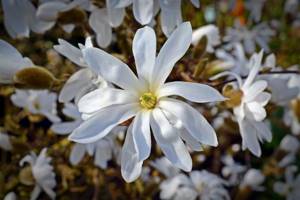
Magnolia kobus is a low deciduous, slow-growing tree (less commonly a shrub), reaching 8–15 m in height at maturity. It blooms in April, before the leaves appear, forming fragrant white, sometimes pale pink flowers up to 10 cm in diameter on thin, curved branches. In summer, the tree is distinguished by its dark green foliage. The leaves are smooth, ovoid, 10–15 cm long. In autumn they turn yellow and fall off. The fruit is formed from a cluster of small red seeds that birds love to feast on. The old bark is gray-brown in color, and the young branches are greenish in color, with small brown spots.
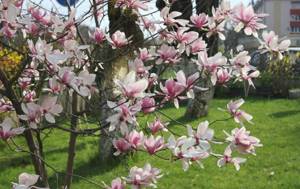
During excavations of an ancient Bronze Age settlement, archaeologists discovered magnolia kobus seeds, the age of which was estimated by scientists at 2000 years. With full confidence that plants would not sprout from them, archaeologists sowed magnolia seeds into the soil. After some time, they had to see that they were wrong - shoots appeared from the seeds, which then grew and turned into young trees.
Kobus magnolia is successfully grown in mid-latitude climates. In many squares, park areas, arboretums, and botanical gardens, it serves as an exotic decoration of the local flora. This species also grows in our city. On the territory of the Poltava State Agrarian Academy there are four trees of the Far Eastern magnolia kobus, the first of which was planted more than 30 years ago. In the first half of April, everyone can come, admire the unique beauty of the blooming magnolia, and take pictures against the backdrop of its snow-white flowers.
The legend of the appearance of magnolia
The plant was brought to Europe from China. And according to an old Chinese legend, beautiful young girls from a destroyed village turned into magnolia flowers. The surviving girl asked her native land for her dead friends to live forever.
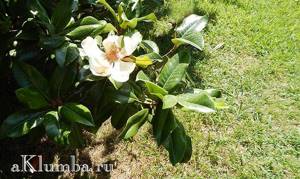
The next morning, the invaders saw a tree that was hung with beautiful flowers. And in their anger, they chopped the tree into small pieces and scattered it as far as possible from this place. But wherever a piece of this tree fell to the ground, a sprout of a new tree called magnolia sprouted.
Expert tips for caring for magnolias
Read about Echinacea flowers here.
Magnolia photo gallery
- Onion fly - how to fight it
- Lobelia - planting and care
- Cineraria - smoky beauty
- We decorate the flowerbed with decorative onions “Allium”
- Sedum - planting and care
- Fixing covering material on the bed
- Forget-me-nots - blue tenderness in the garden
- Limonium - decoration of flower beds
- How to store food in the country without a refrigerator?
- Muscari - early flowers
- Petunia is the most unpretentious flower
- Early spring flowers in the garden



